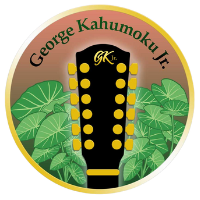
A Hawaiian Perspective on Taro Growing by George Kahumoku Jr.
An introduction by Nancy Kahumoku: This is an essay of George’s I found while scanning his songs from his old songbook to his iPad for him. He wrote it in 1978, enjoy. A Hawaiian Perspective on Taro Growing by George Kahumoku Jr.
Taro has been documented in Chinese history 100 B.C. and Egyptian history 1000 B.C. According to Hawaiian oral history as passed on by Kupuna Aunty Edith Kanaka’ole and shared with those like myself, the Hawaiian genesis of mankind began when Wakea the god of the sky, vibrated with Papa, the earth goddess. The result of this first union was a keiki ‘alu alu or flabby-fetus born-dead. This fetus was buried near the south end of the house where sprung forth the Kalo or taro plant, called Haloa-naka or long-stalk-trembling. Those of us who have been around taro, with a light wind blowing, may have noticed this long stalk trembling behavior first observed by the Gods.
A second union between Wake a and Papa produced man.
Henceforth, according to Hawaiian oral tradition, the Kalo or taro plant is the eldest brother of man. Like the old time Japanese samurai, who believed that the spiritual energy or “mana” was passed on best by the first-born of the first-born of the subsequent generations, the Hawaiians believed that the taro or kalo was spiritually superior to man who was second born. This belief was so strong that only men (not women, because of their monthly cycles) were allowed to work in the taro patch and do the food preparation, including poi pounding. Post missionary contact and new belief systems gave women more freedom in relationship to food growing and the preparation and eating of taro.
Today many of the links between taro and man have survived via the Hawaiian language. The word for family, ohana, comes directly from the word “oha”, or young shoots of the taro, and “na”, the Hawaiian word denoting plurality, or many young shoots. The huli or “keiki” refer to the children in the family.
“The taro that is mature and ready to harvest is called makua, the Hawaiian word for parent. The taro that has long been harvested and eaten is called Kupuna, the Hawaiian word for grandparent.
One of my favorite reasons for planting taro (besides eating) is for the spiritual link to my ancestral older brother, the Kalo. It reminds me of where I came from and where I’m going. Taro also needs the inter-relationship with man in order to survive and do well. This show of affection.
